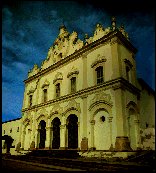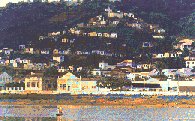Cachoeira
Established as an administrative centre by agents of the Portuguese crown in 1698, the city of Cachoeira (the name means 'Waterfall') overlooks the River Paraguaçu. Unlike most Recôncavo cities, its economy was based on commerce.
Once the gateway to the interior of the state until Bahia's road system passed it by, in its heyday Cachoeira was a major crossroads between the capital and the coast, the rest of the state and other parts of northern and northeastern Brazil. The colonial government even established a mint there.
Sailboats called saveiros laden with sacks of sugar, rolls of tobacco, pottery and passengers regularly docked at Cachoeira's river port. Profits from the city's thriving trade filled merchants' coffers, enabling them to build the elegant homes that still line its streets. Like many prosperous colonists, they preferred investing their riches in sumptuous churches, rather than paying tribute to Portugal. One example is the former Carmelite convent. Now Cachoeira's most popular hotel, its architecture rivals that of the world's greatest monasteries.
Despite its relatively small size, Cachoeira vies with Salvador in the number of its Candomblé terreiros or temples. Every August, the Boa Morte (Good Death) Sisterhood preserves its roots by holding festivals mingling Catholic and African traditions.
Cachoeira still looks much the way it did when the river port was made obsolete by modern asphalt roadways. Today, it is a living sanctuary for Portuguese, Bantu and Sudanese cultural traditions. The blended legacies of Europeans, Africans and Amerindians are reflected in the food, festivals, beliefs, superstitions, divination rites and folkways of its people.
São Félix
Across the river from Cachoeira, there lies the town of São Félix.
The Dom Pedro II Bridge, which links the twin towns, is a famous landmark. Named for a Brazilian emperor, it was built by British engineers in the late 19th century. The bridge was originally intended to span the Nile in Egypt. Today, it is old and rickety, and badly in need of restoring. Some people would rather cross the river by canoe!

Photo by Arlete Soares
Originally a district of Cachoeira, São Félix grew up
around a cigar factory founded by Geraldo Dannemann, who was also its first
mayor. Today, the town's most popular attraction is the former factory.
Now a cultural centre, the Dannemann demonstrates the art of rolling fragrant tobacco leaves -- a task traditionally reserved for the skilled and delicate hands of women -- as well as sponsoring research and exhibits on the arts and history of the Recôncavo.






